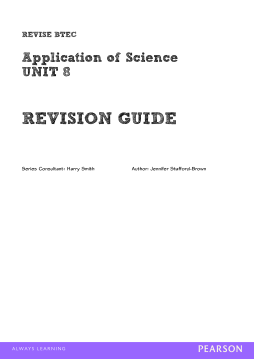
BOOK
BTEC First in Applied Science: Application of Science - Unit 8 Revision Guide
(2017)
Additional Information
Book Details
Abstract
The guide is organised by the assessment structure of the qualification and gives students guidance on the external assessment.
- Key point summaries of what candidates should know are included to reinforce teaching.
- Information is presented in a straightforward, user-friendly way.
Worked examples, exam questions, revision practice questions and 'test yourself' diagnostic questions prepare students for the exams ahead. In addition, the Revision Guide provides students with all the answers to all the questions in the book.
'BTEC Award in Principles of Applied Science Unit 1 Revision Guidereplacement page 4'
'Unfortunately it has come to our attention that the fonts used for the ticks and crosses in the table on page 4 were corrupted to become 3s and 7s. Download a corrected page. The corrections will be included in the first reprint of the Principles of Applied Science Revision Guide.'Table of Contents
| Section Title | Page | Action | Price |
|---|---|---|---|
| Cover | Cover | ||
| Contents | ii | ||
| Learning aim A: Understand how to produce a good plan for an investigation | 1 | ||
| 1: Scientific equipment 1 | 1 | ||
| 2: Scientific equipment 2 | 2 | ||
| 3: Chemistry equipment | 3 | ||
| 4: Physics equipment | 4 | ||
| 5: Biology equipment | 5 | ||
| 6: Risks and management of risks | 6 | ||
| 7: Hazardous substances and control measures | 7 | ||
| 8: Protective clothing | 8 | ||
| 9: Handling microorganisms | 9 | ||
| 10: Microorganisms and wildlife | 10 | ||
| 11: Dependent and independent variables | 11 | ||
| 12: Control variables | 12 | ||
| 13: Measurements | 13 | ||
| 14: Units of measurement | 14 | ||
| 15: Accurate and precise measurements 1 | 15 | ||
| 16: Accurate and precise measurements 2 | 16 | ||
| 17: Range and number of measurements | 17 | ||
| 18: Writing a method | 18 | ||
| 19: Hypotheses | 19 | ||
| 20: Qualitative and quantitative hypotheses | 20 | ||
| 21: Planning an investigation | 21 | ||
| 22: Learning aim A sample questions | 22 | ||
| Learning aim B: Process, present and analyse data, and draw evidence-based conclusions | 23 | ||
| 23: Tables of data | 23 | ||
| 24: Identifying anomalous results from tables | 24 | ||
| 25: Identifying anomalous results from graphs | 25 | ||
| 26: Excluding anomalous results | 26 | ||
| 27: Calculations from tabulated data | 27 | ||
| 28: Calculations from tabulated data-using equations | 28 | ||
| 29: Significant figures | 29 | ||
| 30: Bar charts 1 | 30 | ||
| 31: Bar charts 2 | 31 | ||
| 32: Pie charts | 32 | ||
| 33: Line graphs 1 | 33 | ||
| 34: Line graphs 2 | 34 | ||
| 35: Straight lines of best fit | 35 | ||
| 36: Curves of best fit | 36 | ||
| 37: Selecting types of graph 1 | 37 | ||
| 38: Selecting types of graph 2 | 38 | ||
| 39: Finding values from graphs 1 | 39 | ||
| 40: Finding values from graphs 2 | 40 | ||
| 41: Calculating gradients from graphs | 41 | ||
| 42: Calculating areas from graphs | 42 | ||
| 43: Why anomalous results occur | 43 | ||
| 44: Positive correlation | 44 | ||
| 45: Negative correlation | 45 | ||
| 46: Direct proportion | 46 | ||
| 47: Inverse proportion | 47 | ||
| 48: Using evidence 1 | 48 | ||
| 49: Using evidence 2 | 49 | ||
| 50: Learning aim B sample questions | 50 | ||
| Learning aim C: Evaluate evidence and investigate methods | 51 | ||
| 51: Writing a conclusion 1 | 51 | ||
| 52: Writing a conclusion 2 | 52 | ||
| 53: Inferences | 53 | ||
| 54: Support for a hypothesis 1 | 54 | ||
| 55: Support for a hypothesis 2 | 55 | ||
| 56: Support for a hypothesis 3 | 56 | ||
| 57: Strength of evidence | 57 | ||
| 58: Sufficient data 1 | 58 | ||
| 59: Sufficient data 2 | 59 | ||
| 60: Validity of a conclusion 1 | 60 | ||
| 61: Evaluating an investigation 1 | 61 | ||
| 62: Evaluating an investigation 2 | 62 | ||
| 63: Improving an investigation 1 | 63 | ||
| 64: Improving an investigation 2 | 64 | ||
| 65: Extending an investigation | 65 | ||
| 66: Learning aim C sample questions | 66 | ||
| 67: Answers | 67 | ||
| 72: Your own notes | 72 |
